Intel SSD DC P3700 Review: The PCIe SSD Transition Begins with NVMe
by Anand Lal Shimpi on June 3, 2014 2:00 AM EST- Posted in
- Storage
- SSDs
- Intel
- Intel SSD DC P3700
- NVMe
Sequential Read Performance
Sequential operations still make up a substantial portion of enterprise storage workloads. One of the most IO heavy workloads we run in AnandTech's own infrastructure are our traffic and ad stats processing routines. These tasks run daily as well as weekly and both create tremendous IO load for our database servers. Profiling the workload reveals an access pattern that's largely sequential in nature.
We'll start with a look at sequential read performance. Here we fill the drive multiple times with sequential data and then read it back for a period of 3 minutes. I'm reporting performance in MB/s as well as latency over a range of queue depths. First up, bandwidth figures:
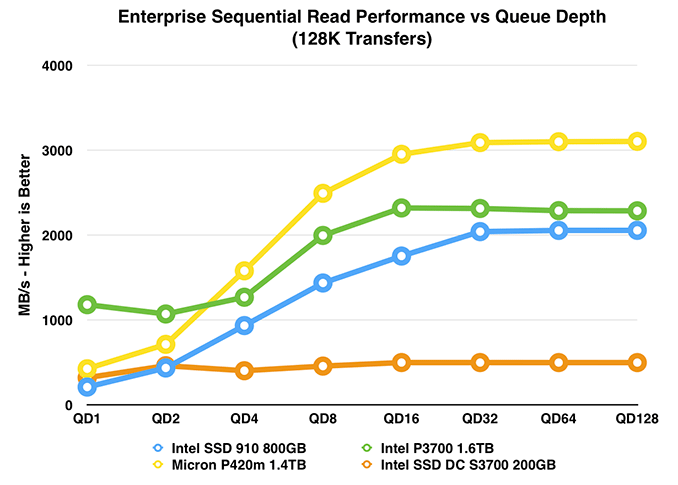
The biggest takeaway from this graph is just how much parallelism Intel manages to extract from each transfer even at a queue depth of 1. The P3700 delivers more than 1GB/s of bandwidth at QD1. That's more than double any of the other competitors here, and equal to the performance of 3.7x SATA Intel SSD DC S3700s. Note that if you force the P3700 into a higher power, 25W operating mode, Intel claims peak performance hits 2.8GB/s compared to the 2.2GB/s we show here.
With NVMe you get a direct path to the PCIe controller, and in the case of any well designed system the storage will communicate directly to a PCIe controller on the CPU's die. With a much lower overhead interface and protocol stack, the result should be substantially lower latency. The graph below looks at average
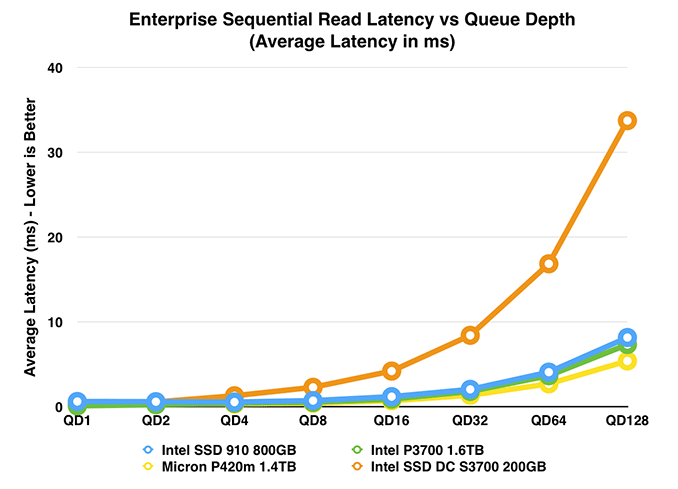
The P3700 also holds a nice latency advantage here. You'll be able to see just how low the absolute latencies are in a moment, but for now we can look at the behavior of the drives vs. queue depth. The P3700's latencies stay mostly flat up to a queue depth of 16, it's only after QD32 that we see further increased latencies. The comparison to the SATA based S3700 is hilarious. The P3700's IO latency at QD32 is lower than the S3700 at QD8.
The next graph removes the sole SATA option and looks at PCIe comparisons alone, including the native PCIe (non-NVMe) Micron P420m:
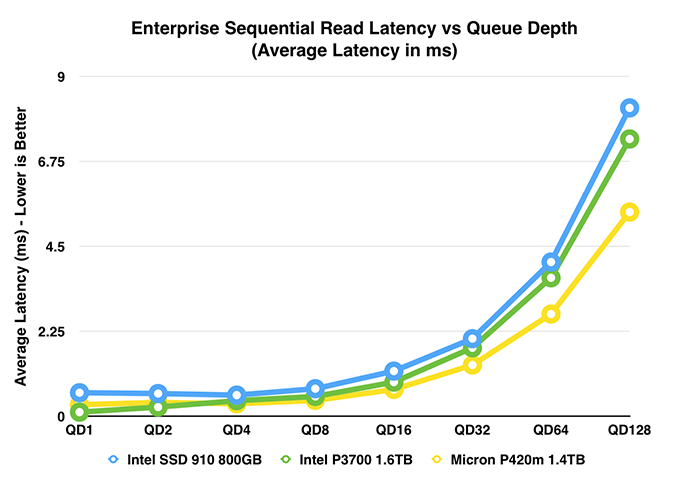
Micron definitely holds the latency advantage over Intel's design at higher queue depths. Remember that the P420m also happens to be a native PCIe SSD controller, it's just using a proprietary host controller interface.
Sequential Write Performance
Similar to our discussion around sequential read performance, sequential write performance is still a very valuable metric in the enterprise space. Large log processing can stress a drive's sequential write performance, and once again it's something we see in our own server environment.
Here we fill the drive multiple times with sequential data and then write it back for a period of 3 minutes. I'm reporting performance in MB/s as well as latency over a range of queue depths.
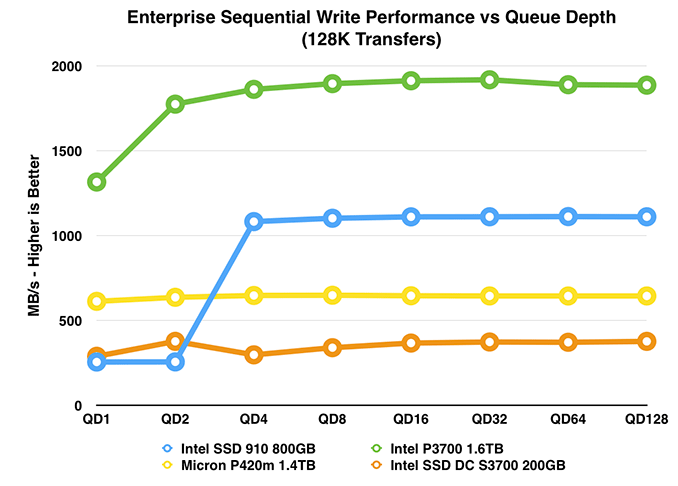
Once again we see tremendous performance at very low queue depths. At a queue depth of 1 the P3700 already performs better than any of the other drives here, and delivers 1.3GB/s of sequential write performance. That's just insane performance at such a low queue depth. By QD4, the P3700 reaches peak performance at roughly 1.9GB/s regardless of what power mode you operate it in.
The chart below shows average latency across the QD sweep:
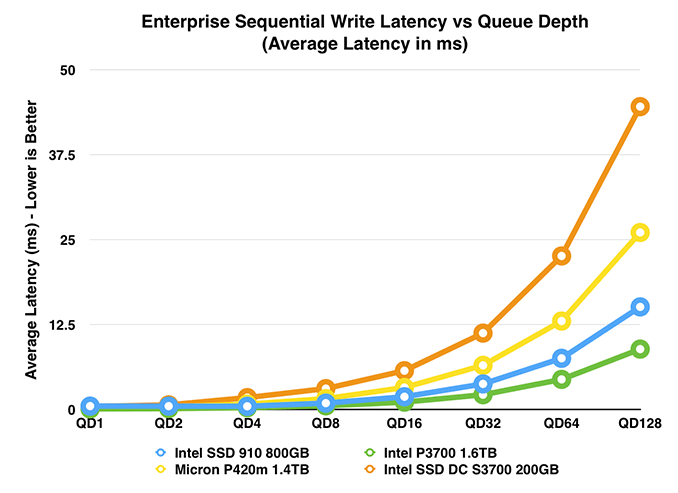
The P3700 continues to do extremely well in the latency tests, although Intel's original PCIe SSD didn't do so badly here either - its bandwidth was simply nowhere as good. Another way to look at it is that Intel now delivers better latency than the original 910, at substantially higher bandwidths. Micron's P420m manages to land somewhere between a good SATA drive and the P3700.
The next chart just removes the SATA drive so we get a better look at the PCIe comparison:
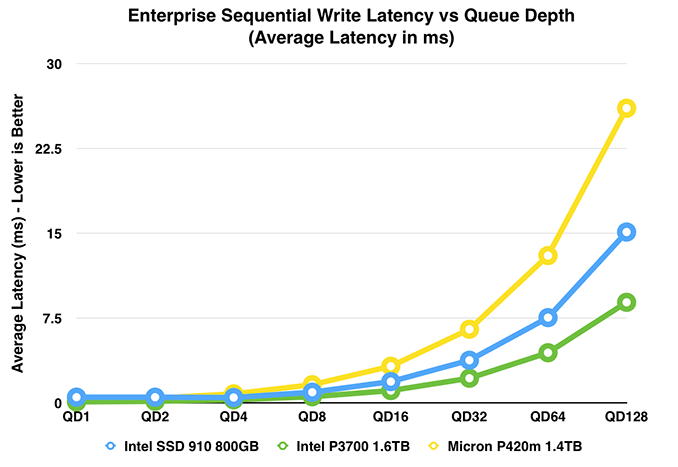










85 Comments
View All Comments
Ammaross - Tuesday, June 3, 2014 - link
The M.2 SATA-protocol-on-PCIe drives? A comparison would mean Apple would need have to have support for NVMe first or the ability to even slot in such a card (rules out the 3 offerings you outlined).extide - Tuesday, June 3, 2014 - link
What are you talking about? "The M.2 SATA-protocol-on-PCIe drives?" doesn't even make sense.All you need to do to compare them is run the benchmarks on the apple hardware, possibly while running under a windows OS. OR, if the drives use the regular m.2 style connector you could just stick them in a desktop. The fact they run AHCI over PCIe does not make a comparison impossible, in fact all of the other PCIe cards in this review that were benchmarked against were also AHCI based cards. Seems like NVMe is confusing people at lot more than it should.
Galatian - Wednesday, June 4, 2014 - link
I think he tried to say that you can't stick one of those new NVMe drives into a Mac, since OS X does not yet support NVMe.That being said, Apple discontinued the old Mac Pro where you could put a PCIe device inside, so the point is moot no matter what.
gospadin - Tuesday, June 3, 2014 - link
I'd have liked to see the drive in 25W mode tooextide - Tuesday, June 3, 2014 - link
Yeah, I would as well. I am assuming the 25W mode has specific cooling requirements? More info on this would be nice. Also what is the default TDP?eanazag - Tuesday, June 3, 2014 - link
That's also the first thing I thought. I wanted to see the boost level. That bottom is pretty close to where I would consider splurging for my desktop with a 400GB. If you consider a RAID card and few drives then $600 is justifiable.I stayed away from the PCIe SSDs because of boot issues and quality concerns. A lot of those were OCZ.
Galatian - Tuesday, June 3, 2014 - link
I might have just overlooked it, but I guess those drives are not bootable?457R4LDR34DKN07 - Tuesday, June 3, 2014 - link
" Booting to NVMe drives shouldn't be an issue either."Galatian - Tuesday, June 3, 2014 - link
Ah great...so this might be a nice alternative to the lackluster state M.2 is right now after all!dopp - Tuesday, June 3, 2014 - link
NVMe won't necessarily be a replacement for M.2. M.2 is just the connector, and the M.2 standard supports both SATA and NVMe as protocols to control the SSD. That said, you need a motherboard that's wired to give PCIe-over-M.2 as well as a drive that supports NVMe, and NVMe M.2 drives will likely be much better than SATA ones.